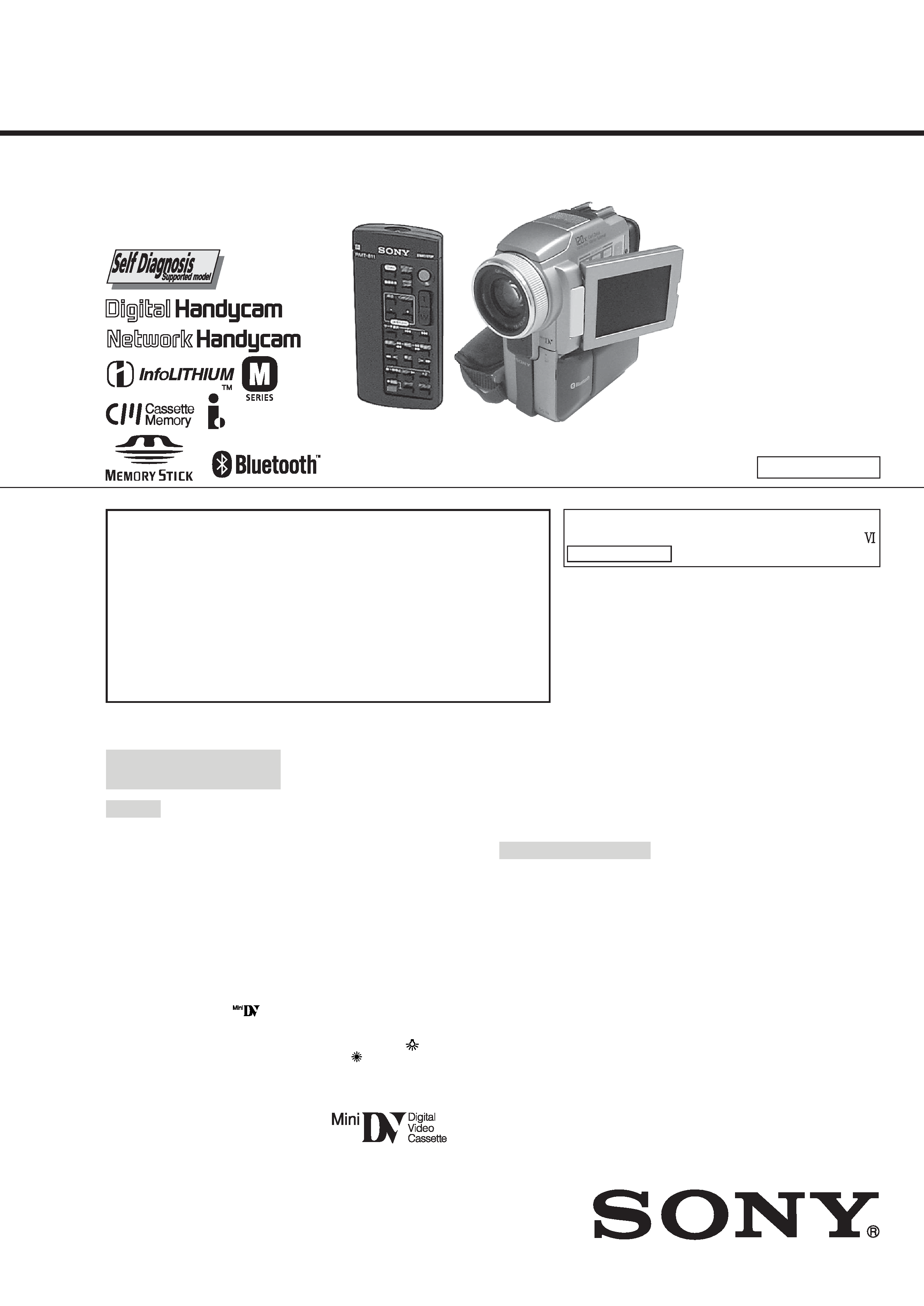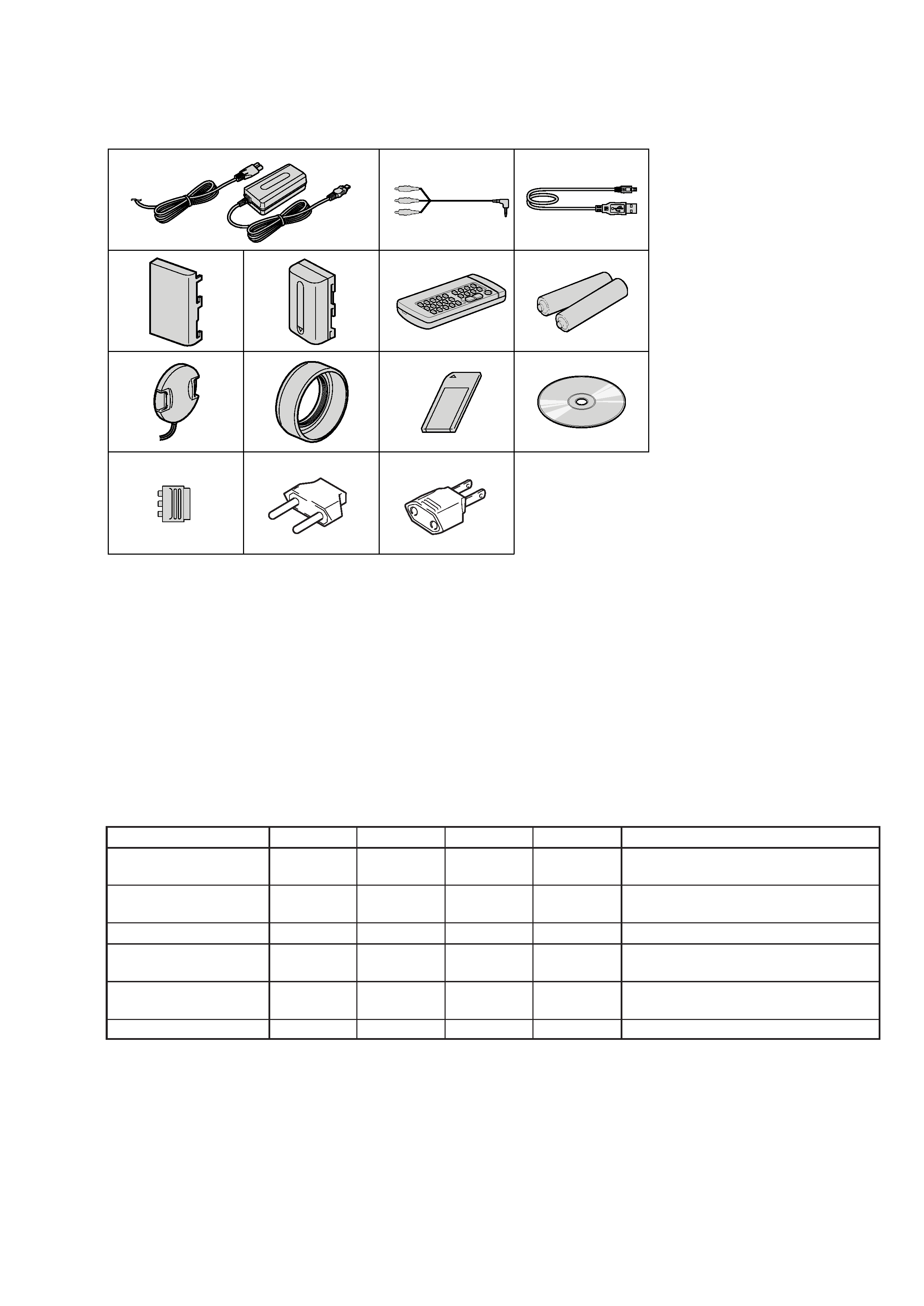
Video camera
recorder
System
Video recording system
2 rotary heads
Helical scanning system
Audio recording system
Rotary heads, PCM system
Quantization: 12 bits (Fs 32 kHz,
stereo 1, stereo 2), 16 bits
(Fs 48 kHz, stereo)
Video signal
PAL colour, CCIR standards
NTSC color, EIA standards
DCR-PC115/PC120BT:
DCR-PC115E/PC120E:
Usable cassette
Mini DV cassette with the
mark printed
Tape speed
SP: Approx. 18.81 mm/s
LP: Approx. 12.56 mm/s
Recording/playback time (using
cassette DVM60)
SP: 1 hour
LP: 1.5 hours
Fastforward/rewind time (using
cassette DVM60)
When using the battery pack:
Approx. 2 min. and 30 seconds
When using the AC power adaptor:
Approx. 1 min. and 45 seconds
Viewfinder
Electric viewfinder (colour)
Image device
4.5 mm (1/4 type) CCD (Charge
Coupled Device)
Approx. 1 550 000 pixels
(Effective (moving): 970 000 pixels)
(Effective (still): 1 390 000 pixels)
Lens
Carl Zeiss Vario-Sonnar T*
Combined power zoom lens
Filter diameter: 37 mm (1 1/2 in)
10
× (Optical), 120× (Digital)
Focal length
4.2 42 mm (3/16 1 11/16 in.)
When converted to a 35 mm still
camera
Camera mode:
48 480 mm (1 15/16 19 in.)
Memory mode:
40 400 mm (1 5/8 15 3/4 in.)
Colour temperature
Auto, HOLD (Hold),
Indoor
(3 200 K),
Outdoor (5 800 K)
Minimum illumination
7 lx (lux) (F 1.8)
0 lx (lux) (in the NightShot mode)*
* Objects unable to be seen due to
the dark can be shot with infrared
lighting.
Input/Output connectors
S video input/output
4-pin mini DIN
Luminance signal: 1 Vp-p,
75
(ohms), unbalanced
Chrominance signal: 0.3 Vp-p,
DCR-PC115/PC120BT:
DCR-PC115E/PC120E:
75
(ohms), unbalanced
Chrominance signal: 0.286 Vp-p,
75
(ohms), unbalanced
Audio/Video input/output
AV MINI JACK, 1 Vp-p,
75
(ohms), unbalanced, sync
negative
327 mV, (at output impedance
more than 47 k
(kilohms))
Output impedance with less than
2.2 k
(kilohms)/Stereo minijack
(ø 3.5 mm)
Input impedance more than
47 k
(kilohms)
DV input/output
4-pin connector
Headphone jack
Stereo minijack (ø 3.5 mm)
LANC jack
Stereo mini-minijack (ø 2.5 mm)
USB jack
mini-B
MIC jack
Minijack, 0.388 mV low impedance
with 2.5 to 3.0 V DC, output
impedance 6.8 k
(kilohms) (ø 3.5
mm)
Stereo type
SERVICE MANUAL
SERVICE MANUAL
DIGITAL VIDEO CAMERA RECORDER
SPECIFICATIONS
For MECHANISM ADJUSTMENTS, refer to the
"DV MECHANICAL ADJUSTMENT MANUAL
J MECHANISM " (9-929-807-11).
-- Continued on next page --
On the VC-270 board
This service manual provides the information that is premised the
circuit board replacement service and not intended repair inside the
VC-270 board.
Therefore, schematic diagram, printed wiring board, waveforms, parts
location and electrical parts list of the VC-270 board are not shown.
The following pages are not shown.
Printed wiring board ......................... Pages 4-19 to 4-22
Schematic diagram .......................... Pages 4-23 to 4-58
Waveforms and parts location ......... Pages 4-92 to 4-94
Electrical parts list ............................ Pages 6-14 to 6-25
DCR-PC115/PC115E/
PC120BT/PC120E
RMT-811
Photo : DCR-PC120E
RMT-811
Canadian Model
DCR-PC120BT
AEP Model
DCR-PC115E/PC120E
UK Model
Australian Model
DCR-PC120E
E Model
DCR-PC115/PC115E/PC120E
Hong Kong Model
DCR-PC115/PC120E
Tourist Model
DCR-PC115/PC115E
Chinese Model
DCR-PC115E
Korea Model
DCR-PC115
NTSC model
: DCR-PC115/PC120BT
PAL model
: DCR-PC115E/PC120E
J MECHANISM
Ver 1.0 2001. 09

-- 2 --
1.
Check the area of your repair for unsoldered or poorly-soldered
connections. Check the entire board surface for solder splashes
and bridges.
2.
Check the interboard wiring to ensure that no wires are
"pinched" or contact high-wattage resistors.
3.
Look for unauthorized replacement parts, particularly
transistors, that were installed during a previous repair. Point
them out to the customer and recommend their replacement.
4.
Look for parts which, through functioning, show obvious signs
of deterioration. Point them out to the customer and
recommend their replacement.
5.
Check the B+ voltage to see it is at the values specified.
6.
Flexible Circuit Board Repairing
· Keep the temperature of the soldering iron around 270°C
during repairing.
· Do not touch the soldering iron on the same conductor of the
circuit board (within 3 times).
· Be careful not to apply force on the conductor when soldering
or unsoldering.
Unleaded solder
Boards requiring use of unleaded solder are printed with the lead-
free mark (LF) indicating the solder contains no lead.
(Caution: Some printed circuit boards may not come printed with
the lead free mark due to their particular size.)
: LEAD FREE MARK
Unleaded solder has the following characteristics.
· Unleaded solder melts at a temperature about 40°C higher than
ordinary solder.
Ordinary soldering irons can be used but the iron tip has to be
applied to the solder joint for a slightly longer time.
Soldering irons using a temperature regulator should be set to
about 350°C.
Caution: The printed pattern (copper foil) may peel away if the
heated tip is applied for too long, so be careful!
· Strong viscosity
Unleaded solder is more viscous (sticky, less prone to flow) than
ordinary solder so use caution not to let solder bridges occur such
as on IC pins, etc.
· Usable with ordinary solder
It is best to use only unleaded solder but unleaded solder may
also be added to ordinary solder.
SAFETY CHECK-OUT
After correcting the original service problem, perform the following
safety checks before releasing the set to the customer.
DCR-PC115/PC115E/PC120BT/PC120E
General
Power requirements
7.2 V (battery pack)
8.4 V (AC power adaptor)
Average power consumption
(when using the battery pack)
During camera recording using
LCD
4.1 W: DCR-PC115E/PC120E
4.4 W: DCR-PC115/PC120BT
Viewfinder
3.6 W: DCR-PC115E/PC120E
3.8 W: DCR-PC115/PC120BT
Operating temperature
0
°C to 40°C (32°F to 104°F)
Storage temperature
20
°C to +60°C
(4
°F to +140°F)
Dimensions (Approx.)
57
× 118 × 113 mm
(2 1/4
× 4 3/4 × 4 1/2 in.)
(w/h/d)
Mass (approx.)
580 g (1 lb 4 oz)
main unit only
690 g (1 lb 8 oz)
including the battery pack
NP-FM50, cassette DVM60 and lens
cap
Supplied accessories
See page 3.
AC power adaptor
Power requirements
100 240 V AC, 50/60 Hz
Power consumption
23 W
Output voltage
DC OUT: 8.4 V, 1.5 A in the
operating mode
Operating temperature
0
°C to 40°C (32°F to 104°F)
Storage temperature
20
°C to + 60°C (4°F to + 140°F)
Dimensions (approx.)
125
× 39 × 62 mm
(5
× 1 9/16 × 2 1/2 in.) (w/h/d)
excluding projecting parts
Mass (approx.)
280 g (9.8 oz)
excluding power cord
Battery pack
Maximum output voltage
DC 8.4 V
Output voltage
DC 7.2 V
Capacity
8.5 Wh (1 180 mAh)
Dimensions (approx.)
38.2
× 20.5 × 55.6 mm
(1 9/16
× 13/16 × 2 1/4 in.)
(w/h/d)
Mass (approx.)
76 g (2.7 oz)
Type
Lithium ion
"Memory Stick"
Memory
Flash memory
8MB: MSA-8A
Operating voltage
2.7 3.6 V
Power consumption
Approx. 45 mA in the operating
mode
Approx. 130
µA in the standby
mode
Dimensions (approx.)
50
× 2.8 × 21.5 mm
(2
× 1/8 × 7/8 in.) (w/h/d)
Mass (approx.)
4 g (0.14 oz)
Design and specifications are
subject to change without notice.
Wireless communications
(DCR-PC120BT/PC120E only)
Communications system
Bluetooth standard Ver.1.1
Max. baud rate1) 2)
Approx. 723 kbps
Output
Bluetooth standard Power Class 2
Communications distance2)
Max. wireless distance Approx. 10 m
(393 3/4 in.) (When connecting to
BTA-NW1 (optional))
Compatible Bluetooth profile3)
Generic Access Profile
Dial-up Networking Profile
Operating frequency band
2.4 GHz band (2.400 GHz-
2.483 5 GHz)
1) Max. baud rate of Bluetooth
standard Ver.1.1
2) Varies according to the distance
between communicating devices,
presence of obstacles, radiowave
conditions, and other factors.
3) This is a specification matched to
specific usage requirements
between Bluetooth compatible
devices. It is laid down in the
Bluetooth standards.
LCD screen
Picture
6.2 cm (2.5 type)
50
× 37 mm (2 × 1 1/2 in.)
Total dot number
211 200 (960
× 220)

-- 3 --
DCR-PC115/PC115E/PC120BT/PC120E
· SUPPLIED ACCESSORIES
Make sure that the following accessories are supplied with your camcorder.
·
Abbreviation
CND
: Canadian model
HK
: Hong Kong model
AUS
: Australian model
CN
: Chinese model
JE
: Tourist model
KR
: Korea model
Table for difference of functions
DCR-
Destination
Color system
NETWORK (Bluetooth)
Flash memory
(VC-270 board IC1406)
SDRAM
(VC-270 board IC1404)
BT-003 board
PC115
E, HK, KR,
JE
NTSC
4Mbit
16Mbit
PC115E
AEP, E, JE,
CN
PAL
4Mbit
16Mbit
PC120BT
CND
NTSC
a
32Mbit
64Mbit
a
PC120E
AEP, UK,
E, AUS, HK
PAL
a
32Mbit
64Mbit
a
Remarks
NTSC: X301 of VC-270 board is 54MHz.
PAL: X301 of VC-270 board is 40.5MHz.
With BT-003 board
8
1
9
0
qd
qf
4567
qa
23
qs
1
2
AC-L10A/L10B/L10C AC power adaptor (1),
mains lead (1)
A/V connecting cable (1)
3
USB cable (1)
4
Battery terminal cover (1)
5
NP-FM50 battery pack (1)
6
Wireless Remote Commander (1)
7
Size R6 (AA) battery for Remote
Commander (2)
8
Lens cap (1)
9
Lens hood (1)
0
Memory Stick (MSA-8A) (1)
qa
CD-ROM (SPVD-004 USB Driver) (1)
qs
21-pin adaptor (1)
DCR-PC115E/PC120E only
qd
2-pin conversion adaptor (1)
DCR-PC115: JE/PC115E: JE only
qf
2-pin conversion adaptor (1)
DCR-PC115: E,HK/PC115E: E/
PC120E: E, HK only

-- 4 --
DCR-PC115/PC115E/PC120BT/PC120E
TABLE OF CONTENTS
SERVICE NOTE
1.
POWER SUPPLY DURING REPAIRS ····························· 7
2.
TO TAKE OUT A CASSETTE WHEN NOT EJECT
(FORCE EJECT) ································································ 7
3.
DISCHARGING OF THE FLASHLIGHT POWER
SUPPLY CAPACITOR ······················································ 8
3-1.
DISCHARGING THE CAPACITOR USING
THE SHORT JIG ································································ 8
3-1-1. PREPARING THE SHORT JIG ········································· 8
3-1-2. DISCHARGING THE CAPACITOR ································· 8
3-2.
DISCHARGING THE CAPACITOR USING THE
REMOTE COMMANDER ················································ 8
3-2-1. DISCHARGING THE CAPACITOR ································· 8
3-2-2. PROCESSING AFTER COMPLETING REPAIRS/
ADJUSTMENTS ································································ 8
SELF-DIAGNOSIS FUNCTION
1.
SELF-DIAGNOSIS FUNCTION ······································· 9
2.
SELF-DIAGNOSIS DISPLAY ·········································· 9
3.
SERVICE MODE DISPLAY ············································· 9
3-1.
Display Method ·································································· 9
3-2.
Switching of Backup No. ··················································· 9
3-3.
End of Display ···································································· 9
4.
SELF-DIAGNOSIS CODE TABLE ································· 10
1.
GENERAL
Main Features ············································································ 1-1
Quick Start Guide ······································································ 1-1
Getting started
Using this manual ·································································· 1-2
Checking supplied accessories ·············································· 1-2
Step 1 Preparing the power supply ········································ 1-3
Installing the battery pack ··················································· 1-3
Charging the battery pack ··················································· 1-3
Connecting to a wall socket ················································ 1-4
Step 2 Setting the date and time ············································ 1-4
Step 3 Inserting a cassette ······················································ 1-5
Recording Basics
Recording a picture ································································ 1-5
Shooting backlit subjects BACK LIGHT ··························· 1-8
Shooting in the dark NightShot/Super NightShot ·············· 1-8
Self-timer recording ······························································· 1-8
Checking the recording END SEARCH / EDITSEARCH /
Rec Review ········································································· 1-9
Playback Basics
Playing back a tape ································································ 1-9
To display the screen indicators Display function ·············· 1-9
Viewing the recording on TV ·············································· 1-10
Advanced Recording Operations
Recording a still image on a tape Tape Photo recording ·· 1-11
Adjusting the white balance manually ································· 1-12
Using the wide mode ··························································· 1-13
Using the fader function ······················································ 1-13
Using special effects Picture effect ··································· 1-14
Using special effects Digital effect ··································· 1-14
Using the PROGRAM AE function ····································· 1-15
Adjusting the exposure manually ········································ 1-16
Focusing manually ······························································· 1-16
Interval recording ································································· 1-17
Frame by frame recording Cut recording ························· 1-17
Advanced Playback Operations
Playing back a tape with picture effects ······························ 1-18
Playing back a tape with digital effects ······························· 1-18
Enlarging images recorded on tapes Tape PB ZOOM ······ 1-18
Quickly locating a scene using the zero set memory function ·· 1-19
Searching the boundaries of recorded tape by title
Title search ····································································· 1-19
Searching a recording by date Date search ······················· 1-20
Searching for a photo Photo search/Photo scan ················ 1-20
Editing
Dubbing a tape ····································································· 1-21
Dubbing only desired scenes
Digital program editing (on tapes) ································· 1-22
Using with analog video unit and your computer
Signal convert function ·················································· 1-25
Recording video or TV programmes ··································· 1-26
Inserting a scene from a VCR Insert editing ····················· 1-27
Audio dubbing ····································································· 1-28
Superimposing a title ··························································· 1-29
Making your own titles ························································ 1-30
Labelling a cassette ······························································ 1-30
Customising Your Camcorder
Changing the menu settings ················································· 1-31
"Memory Stick" Operations
Using a "Memory Stick" introduction ······························ 1-33
Recording still images on "Memory Stick"s
Memory Photo recording ··············································· 1-36
Recording an image from a tape as a still image ················· 1-38
Superimposing a still image in the "Memory Stick" on an
image MEMORY MIX ·················································· 1-39
Recording moving pictures on "Memory Stick"s
MPEG movie recording ················································· 1-41
Recording a picture from a tape as a moving picture ·········· 1-41
Recording edited pictures as a moving picture
Digital program editing (on "Memory Stick"s) ············· 1-42
Copying still images from a tape Photo save ···················· 1-43
Viewing a still image Memory photo playback ················ 1-44
Viewing a moving picture MPEG movie playback ·········· 1-45
Viewing images using computer ·········································· 1-45
Copying the image recorded on "Memory Stick"s to tapes · 1-47
Enlarging still images recorded on "Memory Stick"s
Memory PB ZOOM ······················································· 1-48
Playing back images in a continuous loop SLIDE SHOW ·· 1-48
Preventing accidental erasure Image protection ··············· 1-49
Deleting images ··································································· 1-49
Writing a print mark PRINT MARK ································ 1-49
Using the optional printer ···················································· 1-50
Using the Network function
Accessing the network ························································· 1-50
Troubleshooting
Types of trouble and their solutions ····································· 1-51
Self-diagnosis display ·························································· 1-52
Warning indicators and messages ········································ 1-52
Additional Information
Usable cassettes ··································································· 1-53
About the "InfoLITHIUM" battery pack ····························· 1-54
About i.LINK ······································································· 1-54
Using your camcorder abroad ·············································· 1-55
Maintenance information and precautions ··························· 1-55
Quick Reference
Identifying the parts and controls ········································ 1-57
2.
DISASSEMBLY
2-1.
LCD CABINET (R) ASSEMBLY ··································· 2-3
2-2.
CABINET (L) SECTION ················································ 2-4
2-3.
VTR COMPLETE, CABINET (R) SECTION ··············· 2-6
2-4.
FJ-035 BOARD ······························································· 2-7
2-5.
VM-027 BOARD ···························································· 2-8
2-6.
CD-349 BOARD, LENS DEVICE ·································· 2-8
2-7.
VC-270 BOARD ····························································· 2-9
2-8.
MECHANISM DECK ····················································· 2-9
2-9.
FLASH UNIT (MC) ······················································ 2-10
2-10. FLASH UNIT (ST) ······················································· 2-10
2-11. CABINET (G) BLOCK ASSEMBLY, ETC. ················· 2-11

-- 5 --
DCR-PC115/PC115E/PC120BT/PC120E
2-12. CONTROL SWITCH BLOCK (FK-1850) ··················· 2-12
2-13. CONTROL SWITCH BLOCK (PS-1850) ···················· 2-12
2-14. BLIND PLATE ASSEMBLY ········································ 2-13
2-15. PD-148B BOARD, INVERTER TRANSFORMER
UNIT ············································································· 2-13
2-16. HINGE ASSEMBLY ····················································· 2-14
2-17. CIRCUIT BOARDS LOCATION ································· 2-18
2-18. FLEXIBLE BOARDS LOCATION ······························ 2-19
3.
BLOCK DIAGRAMS
3-1.
OVERALL BLOCK DIAGRAM (1/4) ··························· 3-1
3-2.
OVERALL BLOCK DIAGRAM (2/4) ··························· 3-3
3-3.
OVERALL BLOCK DIAGRAM (3/4) ··························· 3-5
3-4.
OVERALL BLOCK DIAGRAM (4/4) ··························· 3-7
3-5.
POWER BLOCK DIAGRAM (1/3) ································ 3-9
3-6.
POWER BLOCK DIAGRAM (2/3) ······························ 3-11
3-7.
POWER BLOCK DIAGRAM (3/3) ······························ 3-13
4.
PRINTED WIRING BOARDS AND
SCHEMATIC DIAGRAMS
4-1.
FRAME SCHEMATIC DIAGRAM (1/3) ······················· 4-1
FRAME SCHEMATIC DIAGRAM (2/3) ······················· 4-3
FRAME SCHEMATIC DIAGRAM (3/3) ······················· 4-5
4-2.
PRINTED WIRING BOARDS AND
SCHEMATIC DIAGRAMS ············································ 4-8
· CD-349 (CCD IMAGER)
SCHEMATIC DIAGRAM ······························ 4-9
· CD-349 (CCD IMAGER)
PRINTED WIRING BOARD ······················· 4-11
· FP-386 (REMOTE COMMANDER RECEIVER)
PRINTED WIRING BOARD AND
SCHEMATIC DIAGRAM ···························· 4-15
· FP-383 (MEMORY STICK CONNECTOR)
SCHEMATIC DIAGRAM ···························· 4-17
· CONTROL SWITCH BLOCK (ME-1850)
SCHEMATIC DIAGRAM ···························· 4-18
Shematic diagram and printed wiring board of the
VC-270 board are not shown.
Pages from 4-19 to 4-58 are not shown.
· FP-100 (MODE SWITCH), FP-228 (DEW SENSOR),
FP-102 (TAPE TOP/END SENSOR, S/T REEL)
FLEXIBLE BOARDS ·································· 4-59
· VM-027 (RGB DRIVE, TIMING GENERATOR)(1/3)
SCHEMATIC DIAGRAM ···························· 4-61
· VM-027 (MIC AMP)(2/3)
SCHEMATIC DIAGRAM ···························· 4-63
· VM-027 (CONNECTOR)(3/3)
SCHEMATIC DIAGRAM ···························· 4-65
· VM-027 (RGB DRIVE, TIMING GENERATOR,
MIC AMP)
PRINTED WIRING BOARD ······················· 4-67
· FLASH UNIT (MC-1850)
SCHEMATIC DIAGRAM ···························· 4-71
· FLASH UNIT (ST-1850)
SCHEMATIC DIAGRAM ···························· 4-73
· CONTROL SWITCH BLOCK (PS-1850)
SCHEMATIC DIAGRAM ···························· 4-74
· KY-060 (USER FUNCTION)
PRINTED WIRING BOARD ······················· 4-76
· KY-060 (USER FUNCTION)
SCHEMATIC DIAGRAM ···························· 4-77
· CONTROL SWITCH BLOCK (FK-1850)
PRINTED WIRING BOARD ······················· 4-80
· CONTROL SWITCH BLOCK (FK-1850)
SCHEMATIC DIAGRAM ···························· 4-81
· FJ-035 (DC-IN, CHARGE)
PRINTED WIRING BOARD ······················· 4-83
· FJ-035 (DC-IN, CHARGE)
SCHEMATIC DIAGRAM ···························· 4-85
· FP-387 (PANEL OPEN/CLOSE)
SCHEMATIC DIAGRAM ···························· 4-86
· PD-148 (RGB DRIVE, TIMING GENERATOR)
PRINTED WIRING BOARD ······················· 4-87
· PD-148 (RGB DRIVE, TIMING GENERATOR)
SCHEMATIC DIAGRAM ···························· 4-89
4-3.
WAVEFORMS ······························································ 4-91
Waveforms and parts location of the VC-270 board
are not shown.
Pages from 4-92 to 4-94 are not shown.
4-4.
MOUNTED PARTS LOCATION ································· 4-95
5.
ADJUSTMENTS
1.
Adjusting items when replacing main parts and boards. ·· 5-2
5-1.
CAMERA SECTION ADJUSTMENT ··························· 5-4
1-1.
PREPARATIONS BEFORE ADJUSTMENT
(CAMERA SECTION) ··················································· 5-4
1-1-1. List of Service Tools ························································ 5-4
1-1-2. Preparations ····································································· 5-5
1-1-3. Precaution ········································································ 5-7
1.
Setting the Switch ···························································· 5-7
2.
Order of Adjustments ······················································ 5-7
3.
Subjects ··········································································· 5-7
1-2.
INITIALIZATION OF B, C, D, E, F, 7, 8 PAGE DATA ·· 5-8
1-2-1. INITIALIZATION OF C, D, 8 PAGE DATA ·················· 5-8
1.
Initializing the C, D, 8 Page Data ···································· 5-8
2.
Modification of C, D, 8 Page Data ·································· 5-8
3.
C Page Table ···································································· 5-8
4.
D Page Table ·································································· 5-10
5.
8 Page Table ··································································· 5-11
1-2-2. INITIALIZATION OF B PAGE DATA
(DCR-PC120BT/PC120E) ············································ 5-12
1.
Initializing the B Page Data ··········································· 5-12
2.
Modification of B Page Data ········································· 5-12
3.
Writing the Network Default Setting Value ·················· 5-12
4.
B Page Table ·································································· 5-12
1-2-3. INITIALIZATION OF E, F, 7 PAGE DATA ················· 5-13
1.
Initializing the E, F, 7 Page Data ··································· 5-13
2.
Modification of E, F, 7 Page Data ································· 5-13
3.
F Page Table ·································································· 5-13
4.
E Page Table ·································································· 5-15
5.
7 Page Table ··································································· 5-15
1-3.
CAMERA SYSTEM ADJUSTMENTS ························ 5-16
1.
40.5MHz/54MHz Origin Oscillation Adjustment
(VC-270 board) ····························································· 5-16
2.
MR Adjustment ····························································· 5-16
3.
HALL Adjustment ························································· 5-17
4.
MAX GAIN Adjustment ··············································· 5-18
5.
CCD Output 2ch Matching Adjustment ························ 5-18
5-1.
CCD Output 2ch Matching Adjustment (1) ·················· 5-18
5-2.
CCD Output 2ch Matching Adjustment (2) ·················· 5-19
5-3.
CCD Output 2ch Matching Adjustment (3) ·················· 5-21
5-4.
CCD Output 2ch Matching Adjustment (4) ·················· 5-21
5-5.
CCD Output 2ch Matching Adjustment (5) ·················· 5-23
6.
Flange Back Adjustment (Using Minipattern Box) ······· 5-24
7.
Flange Back Adjustment (Using Flange Back Adjustment
Chart and Subject More Than 500m Away) ·················· 5-25
7-1.
Flange Back Adjustment (1) ·········································· 5-25
7-2.
Flange Back Adjustment (2) ·········································· 5-25
8.
Flange Back Check ························································ 5-26
9.
Picture Frame Setting ···················································· 5-26
